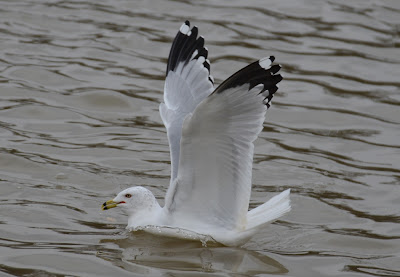Jim McCormac/For the Dispatch
The Columbus Dispatch
NATURE
By Jim McCormac
Sunday, February 19, 2012
Almost everyone can recognize a sea gull. The neatly patterned gray and white birds are fixtures of the seashore.
Perhaps that’s why central Ohioans are surprised to see so many of the feathered scavengers in our landlocked area. Large flocks can be found roosting in mall parking lots, wheeling over rivers and reservoirs, and grabbing rubbish at the landfill.
Probably 98 percent of central Ohio gulls are ring-billed gulls, with a smattering of larger herring gulls mixed in.
Several species can seem to be present in a flock, as some birds are brown while others are clean gray and white.
These different forms represent different ages. It takes a ring-billed gull three years to reach adulthood; a herring gull, four years. They begin life cloaked in dingy brown and each year molt into progressively tidier white and gray plumage.
Dismissing this interesting group of birds as sea gulls does them a disservice. Their family — Laridae — is large and diverse, with 36 gull species known in North America. Their ranks include some of the world’s handsomest birds, and not all are prone to Dumpster-diving.
Two of the rarest species, the ivory and Ross’s gulls, winter along Arctic pack ice, trailing polar bears and mopping up their kills. Beautiful, dainty Bonaparte’s gulls, which are common Ohio migrants, are strict sushi eaters, deftly snagging small fish from the water.
Ring-billed and herring gulls and many of the other large species are omnivores; they’ll eat almost anything. Smart and opportunistic, gulls capitalize on the offal of humans. Our rubbish and castoffs are their fortune.
As human society — and our attendant trash — has expanded, so has the gulls’ population. That’s why we see so many in central Ohio.
From the mid-1800s until the 1920s, ring-billed gulls were slaughtered in great numbers for the millinery trade. Tacky as it might seem, women’s hats were adorned with the feathers of gulls and many other birds — sometimes even the whole bird. When the practice ceased, it took awhile for gulls to rebound, but there are probably more of them than ever.
From 1960 through 1965, only one ring-billed gull was tallied on each of the annual Columbus Christmas Bird Counts. In recent years, counts have reported several thousand birds.
Hard-core bird-watchers love picking through big gull flocks, seeking rarer species. The Franklin County landfill south of town has become a hot spot. Scores of gulls converge there to feed and loaf in nearby fields. Experts have discovered much rarer species among the legions of herring and ring-billed gulls, including Arctic- nesting glaucous, Iceland and Thayer’s gulls, as well as the European lesser black-backed gull.
Ohio’s current most famous avian visitor is also a gull. Since November, a black-tailed gull has frequented Ashtabula harbor on Lake Erie. The Asian species is rare in North America and had never been found before in Ohio. A thousand or more bird-watchers have stopped by to see it, and the gull has been in newspapers and on television.
Naturalist Jim McCormac writes a column for The Dispatch the first and third Sundays of the month. He also writes about nature at www.jimmccormac.blogspot.com.
Further afield
Richard Crossley, author of the newly released The Crossley ID Guide: Eastern Birds, will speak at 7:30 p.m. Feb. 28 at the Grange Insurance Audubon Center, 505 W. Whittier St. Crossley hitchhiked about 100,000 miles while chasing birds around the globe, and he’ll have stories galore. For more information, visit: http://www.columbusaudubon.org/

3 comments:
So which one is the picture?
Ring-billed Gull!
Thanks for this. I've been trying to identify the birds I keep seeing, and I wasn't sure what they were. Many people I've asked continue to say "They can't be gulls, we're not near the sea", but i maintained that they looked suspiciously like gulls. I appreciate your knowledge. :-)
Post a Comment